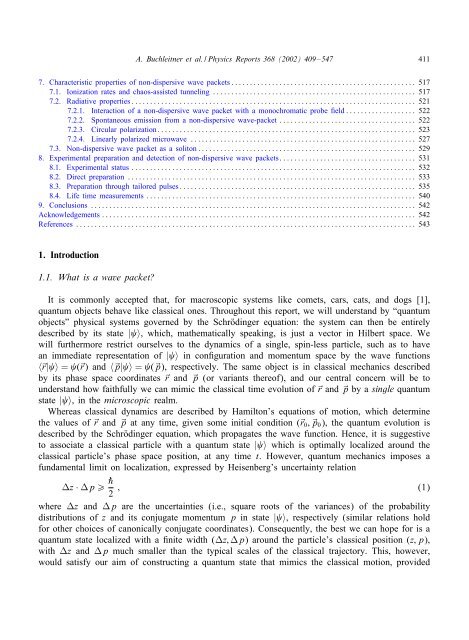Non-dispersive wave packets in periodically driven quantum systems
Non-dispersive wave packets in periodically driven quantum systems
Non-dispersive wave packets in periodically driven quantum systems
Create successful ePaper yourself
Turn your PDF publications into a flip-book with our unique Google optimized e-Paper software.
A. Buchleitner et al. / Physics Reports 368 (2002) 409–547 411<br />
7. Characteristic properties of non-<strong>dispersive</strong> <strong>wave</strong> <strong>packets</strong> .................................................. 517<br />
7.1. Ionization rates and chaos-assisted tunnel<strong>in</strong>g ....................................................... 517<br />
7.2. Radiative properties ............................................................................. 521<br />
7.2.1. Interaction of a non-<strong>dispersive</strong> <strong>wave</strong> packet with a monochromatic probe eld ................... 522<br />
7.2.2. Spontaneous emission from a non-<strong>dispersive</strong> <strong>wave</strong>-packet ..................................... 522<br />
7.2.3. Circular polarization ...................................................................... 523<br />
7.2.4. L<strong>in</strong>early polarized micro<strong>wave</strong> ............................................................. 527<br />
7.3. <strong>Non</strong>-<strong>dispersive</strong> <strong>wave</strong> packet as a soliton ........................................................... 529<br />
8. Experimental preparation and detection of non-<strong>dispersive</strong> <strong>wave</strong> <strong>packets</strong> ..................................... 531<br />
8.1. Experimental status ............................................................................. 532<br />
8.2. Direct preparation .............................................................................. 533<br />
8.3. Preparation through tailored pulses ................................................................ 535<br />
8.4. Life time measurements ......................................................................... 540<br />
9. Conclusions ........................................................................................ 542<br />
Acknowledgements ..................................................................................... 542<br />
References ............................................................................................ 543<br />
1. Introduction<br />
1.1. What is a <strong>wave</strong> packet?<br />
It is commonly accepted that, for macroscopic <strong>systems</strong> like comets, cars, cats, and dogs [1],<br />
<strong>quantum</strong> objects behave like classical ones. Throughout this report, we will understand by “<strong>quantum</strong><br />
objects” physical <strong>systems</strong> governed by the Schrod<strong>in</strong>ger equation: the system can then be entirely<br />
described by its state | 〉, which, mathematically speak<strong>in</strong>g, is just a vector <strong>in</strong> Hilbert space. We<br />
will furthermore restrict ourselves to the dynamics of a s<strong>in</strong>gle, sp<strong>in</strong>-less particle, such as to have<br />
an immediate representation of | 〉 <strong>in</strong> con guration and momentum space by the <strong>wave</strong> functions<br />
〈˜r| 〉 = (˜r) and 〈˜p| 〉 = (˜p), respectively. The same object is <strong>in</strong> classical mechanics described<br />
by its phase space coord<strong>in</strong>ates ˜r and ˜p (or variants thereof), and our central concern will be to<br />
understand how faithfully we can mimic the classical time evolution of ˜r and ˜p by a s<strong>in</strong>gle <strong>quantum</strong><br />
state | 〉, <strong>in</strong>themicroscopic realm.<br />
Whereas classical dynamics are described by Hamilton’s equations of motion, which determ<strong>in</strong>e<br />
the values of ˜r and ˜p at any time, given some <strong>in</strong>itial condition (˜r0;˜p0), the <strong>quantum</strong> evolution is<br />
described by the Schrod<strong>in</strong>ger equation, which propagates the <strong>wave</strong> function. Hence, it is suggestive<br />
to associate a classical particle with a <strong>quantum</strong> state | 〉 which is optimally localized around the<br />
classical particle’s phase space position, at any time t. However, <strong>quantum</strong> mechanics imposes a<br />
fundamental limit on localization, expressed by Heisenberg’s uncerta<strong>in</strong>ty relation<br />
z · p ¿ ˝<br />
; (1)<br />
2<br />
where z and p are the uncerta<strong>in</strong>ties (i.e., square roots of the variances) of the probability<br />
distributions of z and its conjugate momentum p <strong>in</strong> state | 〉, respectively (similar relations hold<br />
for other choices of canonically conjugate coord<strong>in</strong>ates). Consequently, the best we can hope for is a<br />
<strong>quantum</strong> state localized with a nite width ( z; p) around the particle’s classical position (z; p),<br />
with z and p much smaller than the typical scales of the classical trajectory. This, however,<br />
would satisfy our aim of construct<strong>in</strong>g a <strong>quantum</strong> state that mimics the classical motion, provided











